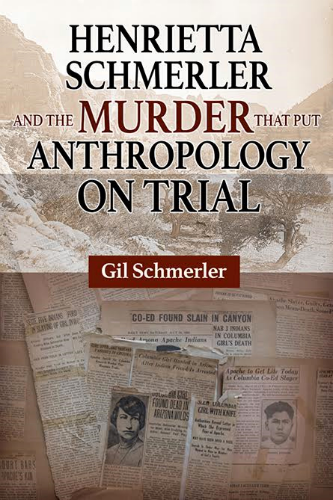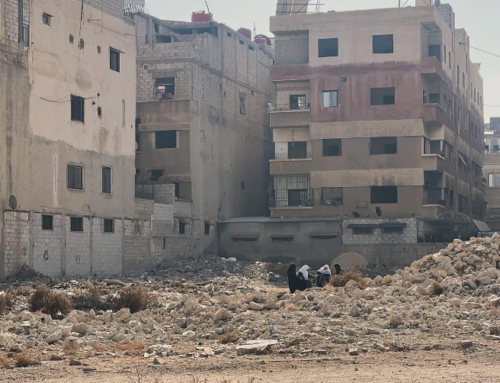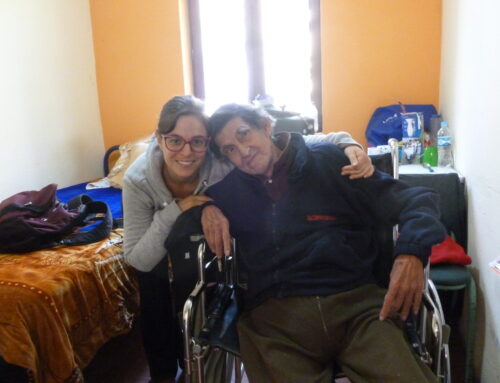
(Courtesy of Gil Schmerler.)
For two years, I have been trying to find a way to talk about Henrietta Schmerler without joining the wake of vultures that have circled her remains relentlessly for decades. Henrietta was a student of Ruth Benedict at Columbia University in the late 1920s. The only extant research we have of hers is an examination of the genealogy of an American Indian myth about rape and incest entitled “Trickster Marries His Daughter” (H. Schmerler 1931). In 1931, the year before The Journal of American Folklore published her article, Henrietta departed to do fieldwork near the town of Whiteriver, Arizona. In July of the same year, she was raped and murdered. A jury in Globe, Arizona found Golney Seymour, a member of the White Mountain Apache Tribe with whom she was conducting ethnographic fieldwork, guilty of her murder.
Unmotivated accounts of Henrietta’s twenty-two years of life and her sudden death are in short supply. The FBI had jurisdiction over the investigation of Henrietta’s murder, and even after the deaths of all involved, they mounted a fierce legal battle to keep the contents of the case file secret (G. Schmerler 1990). An August 1, 1931 article by Arthur Woodward, a museum curator who’d met Henrietta in Arizona, recounts the tendency of American Indians on the reservation to drink a “vile Indian brew” and partake in “orgies” on Saturdays and Sundays. Writing before the confession of the murderer but in a tone characteristic of contemporary accounts, Woodward speculates, “It may be that Miss Schmerler in her ignorance of these drinking bouts attempted to go from her cabin to one of the camps Saturday night or Sunday morning and was either followed or waylaid, assaulted and murdered by some drunken Indian” (Woodward 1931, 69). As the decades passed, the story became even more elaborate. Writing in the September 1986 issue of Anthropology News (then Anthropology Newsletter), Nathalie Woodbury writes, “Unknowing of, or ignoring, the sexual significance of getting up behind a man on his horse, she invited rape and her death. When I taught in New Mexico immediately after World War II the event was still discussed by Southwest Indian students and the aggressiveness and sheer stupidity of the fieldworker were wondered at” (Woodbury 1986, 3). Woodbury’s callous version of events set off a months-long debate in Anthropology News. Two months later, Deborah Tannen wrote in to condemn “the oxymoronic statement” that Schmerler “invited rape and her death” (Tannen 1986, 2). Tannen sensibly points out, “If sexual advances are invited, they are not rape.” The debate continued in the pages of Anthropology News for another year and became the main source for Nancy Howell’s (1990) narrative of the story in Surviving Fieldwork, a book meant to help anthropologists evaluate the risks they take in the field.

(Courtesy of Gil Schmerler.)
While all of the debate in Anthropology News is worth revisiting, I want to dwell on a letter written by Evelyn Kamanitz and Gil Schmerler, Henrietta’s niece and nephew. In the May 1987 issue of Anthropology News, the two of them defend their aunt with an admirable amount of ethnographic rigor:
Nowhere have we found reliable evidence of any specific taboo concerning a single woman riding horseback with an Apache man or that such an action necessarily implies a sexual invitation or assent. Furthermore, the assumption that Henrietta actually did ride with her murderer—or ride voluntarily—rests on the testimony of the murderer and his brother-in-law. (Kamanitz and Schmerler 1987, 2, 4)
Ironically, but not, perhaps, accidentally, these two non-anthropologists are more reflexive about the legacy of Henrietta’s death than many of the other writers. In the same letter, they write,
Every few years for the last half century, the case has been revived…In each instance, the facts have proven elusive, and interpretations contradictory—as they will whenever the primary account of a murder is given by the murderer or by others threatened by the effects of the murder. (Kamanitz and Schmerler 1987, 2)
I count myself as part of the latter group, and—before I eventually reached out to Gil Schmerler—I found this letter difficult to read without feeling responsible for the casual cruelty of other anthropologists. Kamanitz and Schmerler were writing to solicit help from the anthropological community to complete a book manuscript on their aunt’s life. That book—Henrietta Schmerler and the Murder that Put Anthropology on Trial (2017)—was recently completed after three decades of interviews and archival research. It offers the most complete version of the events surrounding Henrietta’s life and death, and it was finished largely without the help of the people Henrietta might have considered her peers: anthropologists.[1]
Although I hope this will be read as something like a tribute I am offering to my anthropological ancestors, I understand that it is a selfish endeavor. After returning from the field in October 2014, I unexpectedly received a grant to go back to my field site for ten months beginning in June 2015; I did not want to go. I revived Henrietta’s case for myself in March of 2015, exactly one year after one of my own interlocutors in Zhengzhou, the capital of Henan Province in the People’s Republic of China, sexually assaulted me. My assailant was—and as far as I know, still is—a high-level official in one of Henan’s provincial ministries. For months after my assault, he and his associates kept tabs on my whereabouts and psychological states, probably to make sure I would not report him to the police or—worse—to the Central Commission for Discipline Inspection. I did not. Instead, I spent my remaining six months in the field scrambling to build an entirely new network of interlocutors and trying, as best I could, to act in public as though nothing had happened.
Even after I was safely back in North America, my anxiety about returning to a city where a powerful man had harmed me kept me from being able to focus. I coped, in part, by trying to build an archive of every anthropologist who had ever been sexually assaulted. I wanted to understand why my assault had surprised me because, in many ways, it shouldn’t have. I was sexually assaulted for the first time when I was 17 years old, and for years afterward, I had drifted toward the PRC because it was a place where I—wrongly, it turns out—felt insulated from gendered violence as a biracial, foreign, and essentially gender-neutral subject. What was it about becoming an “anthropologist” that had made me feel I was safe from the kinds of gendered violence I had learned to accept as part of my “real life” in North America? What was it that had made me feel like fieldwork was life with brackets around it?
Reflecting on it now, I can see that this line of questioning was largely driven by fear and self-recrimination. Blaming myself was one way to comfort myself and invest, disparagingly, in my own agency; if I were responsible for the assault, it would mean that I might be able to prevent another one.² Similarly, blaming Henrietta allows anthropologists to deny their own lack of control in the field; more specifically, it allows anthropologists to deny the existence of gendered vulnerability in the field. The debate in Anthropology News can be represented as a tension between two positions: the ideal political one, represented by Tannen, and the ruthless, pragmatic one, represented by Woodbury. Politically, women should be able to do research as if there will not be gendered consequences; pragmatically, people like Woodbury insist that if women would not be “stupid” and expose themselves, they would not be raped. Because what Woodbury means by “stupid” is ignorant of the cultural implications of her actions, it is worth noting that my own assault occurred after the first jiefeng or welcome back banquet my interlocutors had ever held in my honor. Both the banquet and the assault were evidence not of my ignorance of local customs but of my integration into them; perversely, both events signified that my interlocutors finally recognized me not just as a person who was part of their community but also as a gendered person.
Admitting this, however, can be dangerous to a profession that values both safety and gender parity. As Howell points out in Surviving Fieldwork,
The possibility that women might not be permitted to do fieldwork because of their susceptibility to rape and murder came close to the surface in [the Schmerler case]… women hesitate to speak out about rape or threats of sexual assault for fear that their freedom of action will be restricted. (Howell 1990, 94-95)
In a context where women still fear for the legitimacy of their professional positions, could denial, repression, and blaming the victim have been the pragmatically and politically correct position to take? Believing Henrietta to be responsible for her own rape and murder—even just writing it out highlights the absurdity—shields women anthropologists from having their autonomy infringed upon by people who want to “protect” them (Golde 1970). Believing this makes Henrietta’s misfortune into a tale of “sheer stupidity” rather than the result of a gendered vulnerability that we, as anthropologists, know exists but somehow deny when it comes to ourselves (Woodbury 1986, 3).

(Courtesy of Gil Schmerler.)
Howell and many others who write about danger during fieldwork remain committed to a project of prevention, whose futility is perhaps best articulated by Franz Boas. After learning the details of Henrietta’s death, Boas wrote to Ruth Benedict, “It is dreadful. How shall we now dare to send a young girl out after this? And still. Is it not necessary and right?” (in Howell 1990, 95). Howell and her contemporaries interpreted this as a mentor’s impulse to protect and control his women students; however, I prefer to read it as someone attempting to straddle the line between the political and the pragmatic positions. The “And still” is a hinge upon which Boas’s thought swings into the pre-figurative “as if”; it is the moment in which he entertains the consequences of a moral imperative to make decisions as if the conditions for women to do research freely, without the possibility of distinctly gendered violence, were already in place (Graeber 2014).
This moment was short lived. In the end, Boas colluded with Benedict, the secretary of Columbia University, and the superintendent of Fort Apache Reservation to manipulate Henrietta’s grieving father, who they feared would sue the university or perhaps push for the execution of Henrietta’s murderer.³ (Both those fears turned out to be unfounded.)⁴ Later, in a letter to Margaret Mead—whom Henrietta had also taken classes with and thought of as a mentor—Benedict enthusiastically catalogues the alcohol on hand (during Prohibition!) at a party she threw to celebrate not having to attend the trial of Henrietta’s murderer (G. Schmerler 2017, 169-172).
To be clear, I don’t think that anthropologists necessarily have to answer for what happened to Henrietta in Whiteriver, Arizona. We do, however, have to answer for the discipline’s continued disavowal of Henrietta after her death, for the ways in which our responses to students’ vulnerability might echo Benedict’s callousness toward Henrietta, and for our persistent discomfort with narratives that reveal the inconvenient but real conditions people face as gendered subjects in the field (Johnson 2017; Huang 2016). Revisiting this episode in American anthropology’s history has convinced me that we must do better, though I don’t know exactly how. The key may lie somewhere in Boas’s brief “And still.” There must be a way to think the hinge between the political and the pragmatic, between pushing a door open and letting it slam shut.
In June 2015, I sent myself back to the field. I can say with confidence that it was not necessary; I have no idea whether or not it was right. But I went knowing no one could protect me, knowing that I was vulnerable, and knowing that it was my right to go or not go. The task of the ethnographer is to face the world as it is, even as she attempts to live in the world as if. To face a world in which rape and murder may happen to us, to our students, and to those we love is not the same thing as accepting those acts; it’s merely a way of trying to live with them. The title of this essay is “Doing Fieldwork After Henrietta Schmerler.” I mean the “after” both in the sense of “during the period of time following her” and also “in homage to her.” Schmerler’s gender may have determined how she died, but—by all accounts—she did not allow it to determine how she lived. I have not yet found a way out of the wake of bald, scavenging raptors wringing significance out of Henrietta’s life and death, but her loss now feels strangely personal. I wish we knew more about the work she planned to do.⁵
Endnotes
¹Although the letter spurred one of Henrietta’s field hockey teammates to contact them, Gil Schmerler says none of the other anthropologists involved in the debate ever reached out to him, though he called Woodbury directly sometime in 1987 (personal conversation with Gil Schmerler, July 20, 2017; see also Woodbury 1987, 3).
² I owe this insight to Jing Tsu’s unrelated but brilliant analysis of Chinese intellectuals at the turn of the century (see Tsu 2005, 22).
³ “Letter from Ruth Benedict to Mrs. Heller [sic], February 8, 1932,” written by Benedict, in RFB Papers, 1. Accessed April 8, 2017. https://search.alexanderstreet.com/view/work/bibliographic_entity%7Cbibliographic_details%7C3193158. (Henrietta’s sister was named Mrs. Belle Meller, not Heller.) See also “Letter from Ruth Benedict to Mr. L. [sic] Schmerler, January 27, 1932,” in RFB Papers, 1. Accessed April 8, 2017. https://search.alexanderstreet.com/view/work/bibliographic_entity%7Cbibliographic_details%7C3193157. (She addresses him as “L. Schmerler” though his first name was “Elias.”)
⁴ Gil Schmerler (personal correspondence, July 24, 2017) says Elias Schmerler never had intentions to sue, and he describes in moving detail Elias’ opposition to the death penalty in the book (G. Schmerler 2017, 153-158).
⁵ To learn more about Henrietta Schmerler, go to http://henriettaschmerler.com, where Gil Schmerler has made a number of documents, including Henrietta’s field notes, available to the public.
Acknowledgments
I am grateful to Mingwei Huang, Alix Johnson, Eda Pepi, Susan MacDougall, Vivian Chenxue Lu, Jessica Cooper, Claudia Huang, John Borneman, and Carol Greenhouse for giving me the courage to write this essay. I would also like to thank Dan Goetz and William Vega for their crucial comments on an early draft of this essay, Katie Koch, Miyabi Goto, and Carole McGranahan for the care they took with the final draft, and the members of the Best Writing Group Ever at Princeton University, especially Joel Rozen, for their help with the very first draft. Portions of this essay were presented at the sexual violence roundtable at the American Ethnological Society 2017 spring meeting at Stanford University. Finally, I cannot thank Gil Schmerler and his family enough for their generosity, encouragement, and support.
References
Golde, Peggy. “Introduction.” Women in the Field: Anthropological Experiences. Chicago: Aldine Publishing.
Graeber, David. 2014. “Anthropology and the rise of the professional-managerial class,” Hau: Journal of Ethnographic Theory 4 (3): 73–88.
Howell, Nancy. 1990. Surviving Fieldwork: A Report of the Advisory Panel on Health and Safety in Fieldwork American
Anthropological Association. Washington, D.C.: American Anthropological Association.
Huang, Mingwei. 2016. “Vulnerable Observers: Notes on Fieldwork and Rape.” The Chronicle of Higher Education, October 12.
Accessed November 2, 2017: http://www.chronicle.com/article/Vulnerable-Observers-Notes-on/238042.
Johnson, Alix. 2017. “Violence and Vulnerability in Anthropology.” Allegra Lab: Anthropology, Law, Art & World, October 5.
Accessed November 2, 2017: http://allegralaboratory.net/violence-vulnerability-anthropology/.
Kamanitz, Evelyn, and Schmerler, Gil. 1987. “Henrietta Schmerler—Perspectives and Questions.” Anthropology Newsletter 28 (5): 2, 4.
Schmerler, Gil. 1990. “My Legal Battle with the FBI.” Amherst, Fall 1990): 17-21.
Schmerler, Gil. 2017. Henrietta Schmerler and the Murder that Put Anthropology on Trial. Eugene: Scrivana Press.
Schmerler, Henrietta. 1931. “Trickster Marries His Daughter.” The Journal of American Folklore 44 (172): 196-207.
Tannen, Deborah. 1986. “Blame the Victim?” Anthropology Newsletter 27 (8): 2.
Tsu, Jing. 2005. Failure, Nationalism, and Literature: The Making of Modern Chinese Identity, 1895-1937. Stanford: Stanford
University Press.
Woodbury, Nathalie F S. 1986. “Past Is Present: ‘Adventure’ in Anthropology.” Anthropology Newsletter 27 (6): 3.
Woodbury, Nathalie F S. 1987. “John Kilepak Kisokau: A Man of Two Ways.” Anthropology Newsletter 28 (6): 3
Woodward, Arthur. 1931. “Vile Indian Brew Believed Linked with Schmerler Murder.” The Science News-Letter. August 1: 69.
Cite as: Steffen, Megan. 2017 “Doing Fieldwork After Henrietta Schmerler: On Sexual Violence and Blame in Anthropology,” American Ethnologist website, November 13. http://americanethnologist.org/features/reflections/doing-fieldwork-after-henrietta-schmerler
Megan Steffen is Postdoctoral Research Fellow at the Tsinghua-Michigan Society of Fellows.




